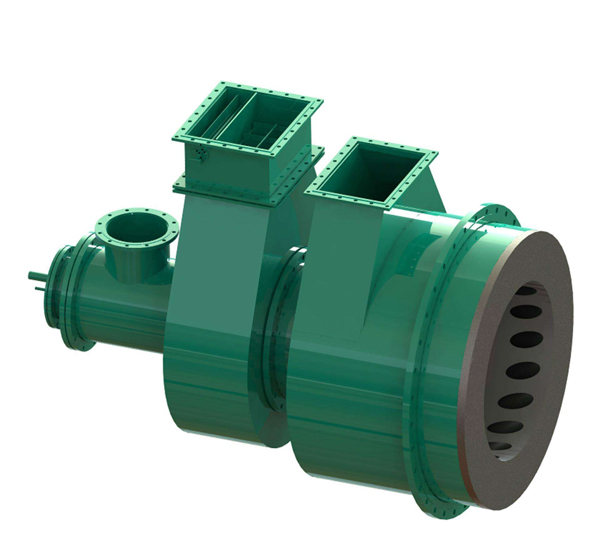一、确定改造目标值
(1)在燃用电厂目前运行煤种时,500MW~1000MW负荷时,NOX排放值控制200~150mg/Nm3。该目标值通过脱硝装置降NOX能力、
低氮燃烧器降NOX能力综合比对所得。
(2)改造后,锅炉不完全损失、排烟损失无明显变化。
(3)改造后,锅炉结焦性、高温腐蚀性、汽温汽压特性等与改造前相当。
1. Determine the target value of transformation
(1) when the coal is currently in operation in the fuel power plant, the NOX emission value is controlled from 200 to 150mg/Nm3 at the load of 500MW~1000MW. The target value was obtained by comprehensive comparison of NOX reduction capacity of denitrifying device and NOX reduction capacity of low nitrogen burner.
(2) after the modification, there is no obvious change in incomplete loss and smoke discharge loss of the boiler.
(3) after the modification, the characteristics of coking, high temperature corrosion and steam temperature and vapor pressure of the boiler are the same as before the modification.
二、1000MW塔式炉低氮燃烧器如何改造?
1.
低氮燃烧器改造方案一
(1)在原六层SOFA燃尽风上方新增加三层的SOFA燃尽风。改造后,总的SOFA燃尽风风量占总风量的比率将由原先的23%提高至40%左右。
(2)更换主燃烧器区域全部二次风喷口,缩小二次风通流面积。
(3)更换主燃烧器区域一次风煤粉喷嘴、喷管及弯头。
2.低氮燃烧器改造方案二
仅在原六层SOFA燃尽风上方新增加三层的SOFA燃尽风,其他燃烧器不改动。
3.改造方案对比分析
(1)方案一:改造工程量大,改造费用较高;
(2)方案二:影响锅炉燃烧效率,且存在部分安全隐患,详细分析如下:锅炉原二次风率为79.16%,燃尽风风率为23%,主燃区二次风率为56.16%,二次风设计速度为60.3m/s。如该造后新增一段燃尽风,风率为17%,而主燃区二次风通流面积不减小,则二次风通流面积增加17/79.16=21.475%。改造后二次风速降为49.64m/s。
1000MW机组塔式锅炉炉膛横截面较大,需要较高的二次风速,才能保证火炬的穿透深度和影响深度,才能到达相邻燃烧器的喷口附近,点燃相邻的燃烧器,才能有效地促进煤粉的燃烧。二次风速降低,将对炉内流场产生不利影响,一方面不利于煤粉的燃烧,另一方面二次风对一次风的风包粉效果减弱,锅炉结渣和高温腐蚀的风险升高。
通过综合比对,选择改造方案一。
2. How to transform the low-nitrogen burner of 1000MW tower furnace?
1. Low-nitrogen burner renovation scheme 1
(1) the original six-layer SOFA is a newly added three-layer SOFA. After the renovation, the ratio of the total SOFA exhaust air volume to total air volume will be increased from the original 23% to about 40%.
(2) replace all secondary air vents in the main burner area to reduce the secondary air flow area.
(3) replace the primary air pulverized coal nozzle, nozzle and elbow in the main burner area.
2. Low-nitrogen burner renovation plan ii
Only the original six-layer SOFA has a new three-layer SOFA with no changes in other burners.
3. Comparative analysis of transformation plans
(1) scheme 1: large amount of renovation project and high renovation cost;
(2) scheme 2: it affects the combustion efficiency of the boiler, and there are some safety risks. The detailed analysis is as follows: the primary secondary air rate of the boiler is 79.16%, the burnout wind rate is 23%, the secondary air rate of the main combustion zone is 56.16%, and the secondary air design speed is 60.3m/s. If a new section of exhaust air is added after the construction, the wind rate is 17%, while the area of secondary air flow in the main combustion area does not decrease, the area of secondary air flow increases by 17/79.16=21.475%. After the reconstruction, the secondary wind speed dropped to 49.64m/s.
The cross-section of the furnace of the tower boiler of 1000MW unit is large, so it needs high secondary wind speed to ensure the penetration depth and influence depth of the torch, to reach the vicinity of the nozzle of the adjacent burner, to ignite the adjacent burner, and to effectively promote the combustion of coal powder. The decrease of secondary wind speed will have adverse effects on the flow field in the furnace. On the one hand, it is not conducive to the combustion of coal powder; on the other hand, the secondary wind will weaken the effect of primary wind on the wind packing powder, and the risk of slag formation and high temperature corrosion of the boiler is increased.
Through comprehensive comparison, choose reform plan 1.
三、改造后调试工作
1.合理控制NOX排放值低氮燃烧器改造后,合理控制NOX排放值很重要。NOX控制偏低,则可能影响锅炉燃烧效率,严重时,可能造成严重的高温腐蚀。
通过合理的燃烧控制调整,500MW~1000MW负荷时,可以将NOX排放值控制在既定设计范围之内:200~150mg/Nm3,既能够保证机组经济性基本不受影响,也能消除低氮燃烧器改造后可能存在的安全隐患。
按照这一核心思想,对不同运行工况下,进行燃烧调整;并根据最佳调整效果,对各燃烧自动控制系统进行适配性优化。
2.改造前后效果对比
(1)NOX排放值月平均降低70mg/Nm3;
(2)锅炉各项燃烧损失基本不变;
(3)因NOX排放较少,每日耗氨量约下降2t/h左右,每吨氨量3000元计算,年度共节约219万元。
(4)改造后,主再汽温比原先值偏高2~3益,但是通过调整后,基本不影响机组经济性。
(5)改造后,锅炉结焦性、高温腐蚀、变负荷稳定性等无明显变化。
Iii. Commissioning after renovation
1. It is important to control NOX emission value reasonably after the modification of the low nitrogen burner. Low NOX control may affect the boiler combustion efficiency, and in severe cases, may cause severe high temperature corrosion.
Through reasonable combustion control adjustment, when 500MW~1000MW is loaded, the NOX emission value can be controlled within the set design range: 200mg /Nm3, which can not only ensure the basic economic efficiency of the unit is not affected, but also eliminate the potential safety risks after the modification of the low-nitrogen burner.
According to this core idea, the combustion adjustment is carried out under different operating conditions. According to the optimal adjustment effect, the adaptive optimization of each combustion automatic control system is carried out.
2. Comparison of effects before and after transformation
(1) the monthly average reduction of NOX emission value was 70mg/Nm3;
(2) the burning loss of the boiler is basically unchanged;
(3) due to low NOX emission, the daily consumption of ammonia decreased by about 2t/h, and the annual consumption of ammonia was calculated at 3,000 yuan per ton, saving a total of 2.19 million yuan.
(4) after the modification, the main steam temperature is 2~3 times higher than the original value, but after the adjustment, the unit economy will not be affected.
(5) after the modification, there is no obvious change in boiler coking, high temperature corrosion, variable load stability, etc.
如果想了解更多关于
低氮燃烧器相关知识,请咨询
北京众诚永源节能环保技术有限公司。
For more information on low nitrogen burners, please consult Beijing chuangwei electromechanical equipment co., LTD.
 返回列表
返回列表 